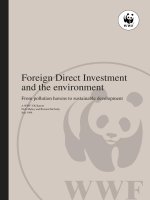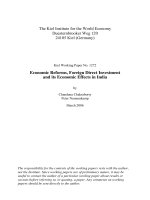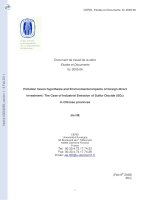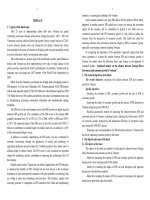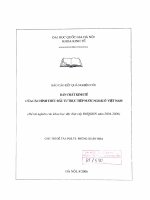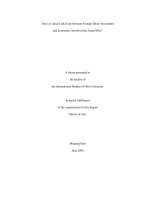The nexus between institutions, foreign aid and foreign direct investment
Bạn đang xem bản rút gọn của tài liệu. Xem và tải ngay bản đầy đủ của tài liệu tại đây (298.54 KB, 64 trang )
UNIVERSITY OF ECONOMICS
INSTITUTE OF SOCIAL STUDIES
HO CHI
THE
MINH
HA
CITY
GUE
VIET
THE
NAM
NETHE
RLAND
S
VIETNAM - NETHERLANDS
PROGRAMME FOR M.A IN
DEVELOPMENT ECONOMICS
THE
NEXU
S
BET
WEE
N
INSTI
TUTI
ONS,
FORE
IGN
AID,
AND
FORE
IGN
DIRECT
INVESTME
NT
BY
LE M. TUE
MASTER OF ARTS IN
DEVELOPMENT
ECONOMICS
HO CHI MINH
CITY, JULY
2015
UNIVERSITY OF ECONOMICS
HO CHI MINH CITY
VIETNAM
INSTITUTE OF SOCIAL STUDIES
THE HAGUE
THE NETHERLANDS
VIETNAM - NETHERLANDS
PROGRAMME FOR M.A IN
DEVELOPMENT ECONOMICS
THE
NEXU
S
BET
WEE
N
INSTI
TUTI
ONS,
FORE
IGN
AID,
AND
FORE
IGN
DIRE
CT
INVESTME
NT
A thesis submitted in partial fulfilment of the
requirements for the degree of
MASTER OF ARTS IN DEVELOPMENT
ECONOMICS
BY
LE M. TUE
Academic Supervisor:
Dr. DINH CONG KHAI
HO CHI MINH
CITY, JULY
2015
CERTIFICATION
I certify that the substance of this thesis has not already been submitted for any degree, and
has not been currently submitted for any other degree.
I certify that, to the best of my knowledge, help received in preparing this thesis and all
sources used have been acknowledged in this thesis.
July 2, 2015
Le M. Tue
ACKNOWLEDGMENT
I am grateful to Dinh Cong Khai, my academic supervisor, and Pham Khanh Nam, a member
of the VNP scientific committee, for helpful and detailed comments.
ABSTRACT
This paper examines the mutual relationship between foreign aid and foreign direct
investment (FDI), which might be ambiguous by reverse causality or simultaneity problems.
Using the dual-approach dynamics-balanced (DADB) model, we are able to point out that
both bilateral and multilateral aid could lead to more FDI, and the impact of the latter could
be even larger than that of the former. The institutional effect of multilateral aid is proposed
to explain this phenomenon. Interestingly, the role of political stability could surpass those of
democracy and control of corruption in having more aid disbursements.
CONTENTS
1.
INTRODUCTION ............................................................................................................
1.1. Practical Motivation and Research Problems .........
1.2. Research Objectives ...............................................
1.3. Structure .................................................................
2.
LITERATURE REVIEW ................................................................................................
3.
MODEL AND DATA .......................................................................................................
3.1. Dual-Approach Framework ....................................
3.2. Dual-Approach Dynamics-Balanced Model ..........
4.
RESULTS ........................................................................................................................
4.1. Independent Marginal Effects between Institutions
4.2. Reliability and Robustness Checks .......................
5.
CONCLUDING REMARKS .........................................................................................
5.1. Empirical Findings ................................................
5.2. Policy Implication .................................................
5.3. Research Contribution, Implication, and Limitatio
5.4. Future Research .....................................................
REFERENCES .......................................................................................................................
APPENDIX A .........................................................................................................................
APPENDIX B .........................................................................................................................
LIST OF FIGURES
Figure 1: The Nexus between Institutions, Foreign Aid, and FDI. ............................................
LIST OF TABLES
Table 1: Descriptive Statistics. ................................................................................................
Table 2: Independent Marginal Effects between Institutions, Foreign Aid, and FDI, 19962012..........................................................................................................................................
Table 3: The Impacts of Different Institutional Measures on FDI and Foreign Aid. ..............
Table 4: Independent Estimation of the Dynamic FDI Equation. ...........................................
Table 5: Independent Estimation of the Dynamic Aid Equations. ..........................................
LIST OF APPENDICES
Table A 1: Variables and Data Sources. ..................................................................................
Table B 1: Regression Result of Table 2, column (1)..............................................................
Table B 2: Regression Result of Table 2, column (2)..............................................................
Table B 3: Regression Result of Table 2, column (3)..............................................................
Table B 4: Coefficient of INSA index in Table 3, Panel A, column AA. ...............................
Table B 5: Coefficient of INSA index in Table 3, Panel A, column BA.................................
Table B 6: Coefficient of INSA index in Table 3, Panel A, column MA. ...............................
Table B 7: Regression Result of Table 4, column (7)..............................................................
Table B 8: Regression Result of Table 4, column (8)..............................................................
Table B 9: Regression Result of Table 4, column (9)..............................................................
Table B 10: Regression Result of Table 5, column (7)............................................................
Table B 11: Regression Result of Table 5, column (8)............................................................
Table B 12: Regression Result of Table 5, column (9)............................................................
Figure B 1: Scree Plot of Eigenvalues of Components for Five Variables of INSF index. .....
Figure B 2: Scree Plot of Eigenvalues of Components for Three Variables of INSA index. ..
1. INTRODUCTION
1.1.
Practical Motivation and Research Problems
From the behavior aspect, when a country receives more aid from a donor, it will
acknowledge the generosity of that donor, easily cooperate with that sovereign partner, and
create a concessionary legal environment for the enterprises of that donor (Kimura & Todo,
2010; Rodrik, 1995, p. 25). From the effectiveness aspect, when a country receives more aid
from all donors, it is able to improve the social and economic infrastructures, thus the human
capital as well as the total factor productivity increase accordingly (Harms & Lutz, 2006).
Hence, the recipient country would be able to attract more FDI from any other countries due
to its increasing competitiveness. In both of the explanations, foreign aid should be a
significant factor of private capital inflows, which are generally accepted to vigorously
promote growth, technology, and employment in the host country. Nevertheless, research
studies have not found a robust relationship between foreign aid and FDI (Alesina & Dollar,
2000; Harms & Lutz, 2006).
Harms and Lutz (2006) suggest that one should consider the role of political and
institutional characteristics when quantifying this relationship. Indeed, institutional quality of
the host country itself is an important direct magnet of private capital inflows. Abundant
empirical studies have pointed out the negative causality of a bad institution to the inflows of
FDI. Ironically, several countries which are perceived as having high corruption and low
political, institutional profiles still have large inflows of FDI (Habib & Leon, 2002).
In the aspect of modeling, the influence of foreign aid on FDI is difficult to estimate due
to the problems of simultaneity and reverse causality. By using lagged variables as
instruments, 2SLS and GMM methods, to some extent, could alleviate such endogeneity.
However, the treatment is purely technical and does not reflect the nature of the problems.
Asiedu, Jin, and Nandwa (2009) propose a simultaneous equations model that could solve
these problems. In this approach, foreign aid and FDI are determined at the same time, and
each of them is the determinant of the other. While the dual approach is undoubtedly a superb
idea, the applied model and the results of this research nonetheless contain some flaws and
contradictions. First, there is no institutional determinant in the aid equation. Second, in the
aid equation, the positive coefficient of FDI could be interpreted that while foreign aid
reduces FDI, FDI could, however, increase foreign aid.
1
1.2.
Research Objectives
This paper aims to modify the simultaneous equations model of Asiedu et al. (2009) and
visualize the intricate relationship between foreign aid and FDI, which might comprise
simultaneity and reverse causality. With regard to purposes, while Asiedu et al. (2009) focus
on the alleviating role of foreign aid on the adverse effect of expropriation risk on FDI, we
concentrate on the effect of foreign aid on final FDI. With regard to samples, we use both
low-income and middle-income subsamples to support our analysis, whereas it is only the
low-income countries in Asiedu et al. (2009). In comparison with Harms and Lutz (2006), we
apply a different model with different proxies of variables and a more recent period to assess
the effect of foreign aid on FDI.
After setting up the framework and specifying the according model, we use the data to
illustrate the mutual relationship between foreign aid and FDI. Using this result, we expect to
figure out whether multilateral aid could actually lead to more FDI. As for researchers
concerned with the determinants of FDI and foreign aid, this paper provides more empirical
evidence on the role of institutions. In particular, we reexamine whether better institutions
could attract more FDI as postulated in theory and found in many research studies. By the
way, we also appraise the importance of different institutional measures on FDI. In the other
side, do democracy (freedom), control of corruption, and political stability help a country
receive more foreign aid?
1.3.
Structure
In Chapter 2, this paper briefly reviews a trade theory which is widely used to explain the
investment decision of foreign investors and some empirical results based on this theory. We
mainly concentrate on the papers that have institutions and foreign aid as the determinants of
private capital inflows. In Chapter 3, we explain the dual-approach framework and the
regression model. The variables and data sources are also described in this chapter. The
empirical findings and associated explanations are located in Chapter 4. Chapter 5
recapitulates the results for making policy and research.
2
2. LITERATURE REVIEW
We first review the OLI theory on the investment decision of foreign investors; then we
come into the papers mentioning institutions and foreign aid as separate explanatory
variables of FDI; next, we have a look on the research which embeds the political and
institutional factors into the influence of foreign aid on FDI. Lastly, we summarize the
institutional measures which might affect foreign aid.
Dunning (1988, 1998, 2001) built up the OLI paradigm as a general framework to explain
the activities of foreign investors. The ownership advantages are classified as the O
component and emphasize the comparative advantages of firms which can expand their
business abroad. Analyzing the O component provides us with information about the nature
of products and the ability of firms. The location advantages define the L component and are
related to the human and natural resources, the favorable conditions for production, business,
research activities, and the market size in the host country. The internalization advantages
belong to the I component and focus on the aspect of how to lower transaction costs, as firms
decide whether importing intermediate products from markets or internalizing foreign
suppliers into their production chain. The I component could be taken into analysis by firms
at the time of choosing the destination.
Political and institutional factors of the host country are considered as the location
advantages in the OLI framework. The influence mechanism of these factors on foreign
investors are mentioned in the papers such as Habib and Leon (2002) and Dunning and
Lundan (2008). On the empirical side, Habib and Leon (2002) find out a negative relationship
between corruption levels in the host countries and their inflows of FDI. According to Habib
and Leon, foreign investors might see corruption as violating social and professional ethics
1
and increasing unnecessary costs. Moreover, paying bribes is strictly prohibited in the home
countries of some foreign investors such as the United States (Hines, 1995).
Busse and Hefeker (2007) examine the impacts of government stability, law and order,
absence of internal and external conflicts, lack of ethnic tensions, control of corruption,
democracy, and bureaucratic performance on FDI inflows to developing countries in the
period 1984-2003. The paper does show positive relationships between such measures and
private capital inflows. With the same period of research, Bénassy-Quéré, Coupet, and Mayer
1Wei (2000) views corruption as a kind of tax on foreign investors.
3
(2007) use the gravity model to test the influences of various institutional data on FDI stocks.
In general, a country owning higher institutional quality would have a larger aggregate stock
of FDI, and higher institutional distance between the home country and the host country
lowers the FDI stock of the former in the latter. In other words, bad institutional measures
would hinder FDI to a country. For example, one of the results in Asiedu et al. (2009) is that
expropriation risk restrains the investment decision of foreign enterprises. The samples of this
research are low-income and Sub-Saharan African countries.
On the other hand, the number of research studies that find out bad institutions as an
incentive of FDI is quite limited. Egger and Winner (2005) show the empirical evidence on
the positive relationship between corruption and inward FDI. The research uses a sample of
both developed and developing countries in the period 1995-99 to strengthen the position of
Leff (1964): bribing could reduce uncertainty among low-informational countries and
safeguard foreign investors under major economic and political changes.
In contrast to institutions, the role of foreign aid per se on FDI is ambiguous when
analyzing the data. As hypothesized by some authors, foreign aid does not only have the
positive effect on FDI, but also the adverse effect. The two simultaneous contradictory effects
could be infrastructure effect and rent-seeking effect (Harms & Lutz, 2006), or complement
and substitution (Selaya & Sunesen, 2012). As a result, many research studies could not find
a significant influence of aggregate aid on FDI (Bird & Rowlands, 1997; Harms & Lutz,
2006; Kimura & Todo, 2010). Selaya and Sunesen (2012) is a sparse research which finds out
the dominance of the positive effect. However, the role of bilateral aid in attracting FDI is
more robust and could be found in Rodrik (1995) and Kimura and Todo (2010). For
multilateral aid, there has been no empirical evidence that it could instantly enhance FDI
(Rodrik, 1995). In the worst case, negative coefficients of aggregate aid, bilateral aid, and
multilateral aid in the FDI regressions are exposed in the research of Asiedu et al. (2009) for
low-income and Sub-Saharan African countries.
Aiming to address the vague impact of foreign aid on FDI, Harms and Lutz (2006) allow
the marginal effect of foreign aid in the FDI equation to be dependent upon institutional
variables, use different estimation techniques, time periods and country groups, and even
disaggregate the types of foreign aid and private foreign investment. Unfortunately, in line
with previous papers, the authors still conclude that: on average, there is no effect of foreign
aid on FDI. Yet, the authors discover a remarkable result: only in the countries with high
regulatory hindrance, i.e. low institutional quality, foreign aid has a positive effect on FDI. As
noted by the authors, this phenomenon emerges because the role of foreign aid as
4
reducing expropriation risk, thus increasing foreign investment, becomes conspicuous in
those countries. Similarly, the positive coefficient of the interaction term between
expropriation risk and foreign aid in Asiedu et al. (2009) means that expropriation risk is
positively added to the effect of foreign aid on FDI. Given the negative coefficient of foreign
aid at the beginning, the increase of expropriation risk level, to some extent, could make
foreign aid moving in the same direction with FDI, although expropriation is perceived as a
bad practice.
In regard to institutional determinants of foreign aid, Alesina and Dollar (2000), Dollar
and Levin (2006) have consensus on the positive impact of democracy. Corruption level,
however, is not found to ultimately affect the decision of a majority of donors (Alesina &
Weder, 2002).
5
3. MODEL AND DATA
3.1.
Dual-Approach Framework
Figure 1 graphically illustrates the influence of institutions on foreign aid and FDI, and
the interaction between these two foreign inflows. The former induces simultaneity and the
latter causes reverse causality. Solid arrows are the foci of this paper. In the bottom of the
figure, institutions are the major factors of both FDI and foreign aid. The OLI theory suggests
that a better institution could have more FDI inflows. Similarly, foreign aid might be
disbursed more to a country with better governance. Hence, α2 and β2 are expected to be
positive.
The amount of foreign aid received by a recipient could affect aggregate private capital
inflows with an average magnitude α1. In case of multilateral aid, it aims to enhance the
social and economic infrastructures and is typically thought as creating the “infrastructure
effect.” As a matter of fact, this effect does not cover all the cases and is likely to occur in the
long run. In the short run, suppose that country A and country B nearly have the same
conditions as well as the institutional measures. When country A receives more multilateral
aid than country B in a period, it does not necessarily mean that country A could improve its
infrastructure instantly and have better infrastructure than country B, and thus could attract
more foreign investors. This argument especially makes sense insofar as multilateral aid, in
general, is not targeted to support a specific industry. Rather, it is the information and
conditional policy functions of multilateral aid that could invisibly protect foreign investors in
destination countries.2 With this reasoning, this paper proposes the “institutional effect” of
multilateral aid. Two features of the institutional effect are that it could safeguard any foreign
investor, but it could not change the institutional nature in the short run.
In case of bilateral aid, besides productive sectors, a number of its projects are also for
infrastructural development, and it should also have the same infrastructure effect as that of
multilateral aid. In addition, bilateral aid has its own special effect which is known to grease
bilateral private capital inflows and is referred to as the “vanguard effect.” It is noticed that
the vanguard effect of bilateral aid is quite similar to the institutional effect of multilateral
aid, but only applied for bilateral investors. The coefficient α1 is conjectured to be positive in
both cases of foreign aid. The impact level is expected to vary systematically among
2See Rodrik (1995) for detailed discussion on the roles of multilateral aid.
6
governments having different performances. Therefore, the marginal effect of foreign aid
could be expressed as a linear function of institutions, i.e. α1 + δ institution. The idea of
putting political and institutional variables into the effect of foreign aid on FDI was first
employed by Harms and Lutz (2006).
The mechanism through which FDI affects foreign aid could be direct or indirect. The
direct mechanism is suitable to explain the inflows of bilateral aid occurring in the short run.
It means that, when having more FDI in a host country, the government of home country has
more motivation to disburse aid to that location. Of course, it is not mandatory for the
government of home country to do so because any country would welcome FDI. However, as
economic activities somewhat reflect the intimacy in diplomatic relationship between two
countries, the use of FDI as a determinant of bilateral aid is still acceptable. On the other
hand, multilateral donors certainly are not concerned about FDI in recipient countries. To sum
up, in the short run, the coefficient β1 of FDI inflows could be positive in the bilateral aid
equation and neutral in the multilateral aid equation.
In the long run, it is the indirect mechanism that FDI could lead to the change in both
bilateral and multilateral aid. FDI might enhance GDP growth and GDP per capita, and, in
turn, these outcomes decide the amount of foreign aid. 3 In other words, if the inflows of FDI
are actually transformed into the wealth of nation, that host country, eventually, would not
rely on concessionary loans or grants of donors anymore. With this argument, the β1
coefficients of FDI inflows in the bilateral and multilateral aid equations should turn negative
in the long run.
Also from FDI to foreign aid, the marginal effect of the former on the latter could be
adjusted by the institutional quality. Different measures of institutions, such as democracy
and corruption, are found to affect GDP growth and GDP per capita (Acemoglu, Naidu,
Restrepo, & Robinson, 2014; Barro, 1996; Mauro, 1995). By adding institutional factors into
the coefficient of FDI inflows, i.e. β1 + γ institution, we could, in principle, evaluate how an
economy absorbs FDI and makes itself less relied on the support of foreign donors.
3 Some conditions that FDI causes economic growth are human capital (Borensztein, De Gregorio, &
Lee, 1998), absolute and relative nature of FDI (Alfaro, 2003; Mello, 1999), and trade policy
(Balasubramanyam, Salisu, & Sapsford, 1996).
7
Figure 1: The Nexus between Institutions, Foreign Aid, and FDI.
3.2.
Dual-Approach Dynamics-Balanced Model
From the dual-approach framework above, we have the general dual-approach model:
fdi = f1 (α1 aid ,α 2 insf ,λ1others),
aid = f 2 ( β1 fdi , β 2 insa , λ2others).
This model augments the simultaneous equations model of Asiedu et al. (2009) by adding the
political and institutional determinant, insa, in the aid equations. The detailed model for
regression is
infdigdpit
aidgdp = β infdigdp
it
where infdigdpit
inflows of official development assistance (ODA) to country i in year t. Both figures are in
percentage of GDP. The first lag of aid inflows in the aid equations, aidgdpi
, t −1,
is a major
difference in comparison with the previous research of Asiedu et al. (2009). It could be added
because foreign aid is disbursed gradually with the completeness of projects. Together with
the first lag of FDI inflows, infdigdpi
, t −1,
this addition makes the system of two equations
balanced, thus the model is referred to as dual-approach dynamics-balanced model.4
Most of the macro and demographic determinants are inherited from Asiedu et al. (2009),
but some adjustments are made. In the FDI equation, the proxy of economic infrastructure is
the total density of communication utilities (utilcom), which is comprised of telephone lines,
4Some papers using the first lag of FDI as an explanatory variable are Asiedu et al. (2009), Busse and
Hefeker (2007), Jensen (2003), and Gastanaga, Nugent, and Pashamova (1998).
8
mobile cellular, and internet subscribers. However, the increase of current FDI inflows might
provoke the usage of communication system. Thus, we lag this variable to avoid the
interaction with the dependent variable and its first lag in the right-hand side of the equation.
The trade openness (tradeopen) as measured by the total exports and imports over GDP is
also lagged two periods because there is a direct contribution of FDI to this variable in the
same year. As foreign investors expand their business activities to other countries, either in
the form of greenfield or merger and acquisition, they are more likely to export machines,
equipment, materials, and experts to, and import final products from the host country. Also
the consumption of expatriates raises the in-border-exports component of the destination
country.
As depicted in Figure 1, FDI inflows could affect the GDP growth of a country within that
year, so gdpgrow is also lagged two times to eliminate the reverse contribution of FDI inflows
into this explanatory variable. Finally, the institutions that might affect FDI inflows (insf ) are
regulatory quality, control of corruption, government efficiency, rule of law, and political
stability. The impact of these institutional measures will be examined separately in the
regression.
In the aid equations, to avoid the component relationship of foreign aid and FDI in the
current GDP per capita, we lag the variable lngdppc. Apart from the projected negative
relationship between the income level of a country and the amount of aid that it receives, we
also expect that the decreasing rate does not hold constant, in particular diminishes. Hence,
the quadratic component of lngdppc is added. The second macro variable which is debt over
GDP ( debtgdp) is lagged due to the inclusion of foreign aid to the current sovereign debt.
Moreover, the debt in the past is more appropriate to be a determinant of aid disbursements in
the future.
The political and institutional variables of foreign aid (insa) are supposed to be
democracy, control of corruption, and government efficiency. As a demographic factor,
population (lnpop) is used because it could create the small-country effect on the inflows of
foreign aid. With the same institutions and other things equal, a country with lower
population is more homogenous and more likely to receive the support of foreign community.
9
In comparison with the trade openness used in the FDI equation, a smaller population
represents a larger social openness at the country level.
5
3.3. Sample and Data
VARIABLE
Net FDI inflows (% GDP)
Aggregate aid (% GDP)
Bilateral aid (% GDP)
Multilateral aid (% GDP)
Regulatory quality
Control of corruption
Government efficiency
Rule of law
Political stability
INSF index
INSA index
Freedom
ln(GDP per capita)
GDP growth (%)
ln(Population)
Debt (% GDP)
Comm. utilities
Trade openness (% GDP)
M2 (% GDP)
Inflation (%)
Young (%)
Old (%)
Note: Full sample (144 countries) includes low-income (54 countries) and middle-income (90
countries) subsamples.
The target sample of this study is low- and middle-income countries because most of
these countries have received foreign aid. The country classifications based on GNI per capita
are of the World Bank and captured in 2013. 6 The macro data are mostly taken from World
Development Indicators (World Bank, 2014) and World Economic Outlook (IMF, 2014). The
institutional data which is adopted from Worldwide Governance Indicators (World Bank,
2012) includes regulatory quality, control of corruption, government efficiency, rule of law,
and political stability. Due to the temporal limitation of data, the research period is narrowed
down to 1996-2012. In addition, we use democracy score from Freedom House to diversify
5 Dudley and Montmarquette (1976) discuss in detail the relationship between small country and
foreign aid.
6The 2013 income classifications of the World Bank are low income (no more than 1,035 US$),
middle income (1,036-12,615 US$), and high income (no less than 12,616 US$).
10
the sources of these subjective variables. Table 1 summarizes the descriptive statistics. More
details of the variables and the data sources are shown in Table A1 (Appendix A).
11
4. RESULTS
4.1.
Independent Marginal Effects between Institutions, Foreign Aid, and FDI
Table 2 shows the regression results based on the DADB model. Panel A contains the base
regression, which follows exactly the specification of the DADB model, for each type of
foreign aid—aggregate (AA), bilateral (BA), and multilateral (MA). The three variables of
interest are FDI inflows, foreign aid, and institutions. In the FDI equation, five available
measures of institutions—which are rule of law, regulatory quality, control of corruption,
government efficiency, and political stability—are examined one by one. Each variable does
have a positive impact on FDI inflows. The coefficients as well as their significance levels
within the full sample are reported in Panel A of Table 3. Except for the government
performance, all other institutional and political measures are valuable to attract more FDI.
The significance levels are at least 5-percent. Surpassing other measures in the category, the
quality of regulation in the private sector has the largest impact on the investment decisions
of multinational enterprises (MNEs). A one-point higher in this measure of sound policy
results in 0.66 percentage-of-GDP higher of FDI inflows after controlling for the persistence
of these inflows and other conditions.
Since all of the institutional measures have a positive impact on the dependent variable,
we then use the principal component analysis (PCA) to construct a composite institutional
index which represents the role of government policies in promoting FDI. This index is
denoted by INSF and will be used in later FDI-determined regressions. Apart from reducing
the workload, another reason behind this composition is that these measures often move
together. A sound government normally has high scores on rule of law, regulatory quality,
control of corruption, and government efficiency, and there would be little space for political
instability, residential violence, and external conflicts.
In column (2) of Table 2, bilateral aid, as expected, has a positive coefficient in the FDI
equation. This result is similar to Rodrik (1995, p. 44). It could be interpreted that when the
inflows of bilateral aid is higher by 1 percentage of GDP, the inflows of FDI is approximately
higher by 0.18 percentage of GDP, ceteris paribus. Interestingly, in column (3), the effect of
multilateral aid is twice larger than that of bilateral aid with a coefficient of 0.39. The
explanation for the more profound impact of multilateral aid is that while bilateral aid only
improves the inflows of FDI from the countries of bilateral donors, multilateral aid, on the
other hand, attracts foreign investors from all countries. In short, the institutional effect
12
outperforms the “extended” vanguard effect. To check the robustness of the results by using
smaller samples, the impacts of institutions and foreign aid on FDI within the low-income
and middle-income subsamples are reported in the first half of Panel B and C of Table 3. As
observed, the effect of foreign aid on FDI within the low-income countries is more than
double within the middle-income countries, but there is no signal of the effect of institutions
on FDI within the former subsample whatsoever. There are two possible reasons for these
differences. First, there might be a virtual institutional threshold under the perception of
foreign investors. When institutional measures of host countries are below a “threshold
value,” then any difference between them would not be considered. As a matter of fact, the
descriptive statistics in Table 1 show that, on average, the quality of institutions of lowincome countries is lower than that of middle-income counterparts in any aspect. Instead, the
extended vanguard effect of bilateral aid and the institutional effect of multilateral aid have a
more important role in the low-income countries, and it forms the second reason. In the need
of low-interest development finance, less developed countries have to comply with
regulations and requirements of international organizations. Incidentally, these obligations
somewhat affect policies toward foreign private sectors, and in reverse, foreign investors
could have more confidence in these countries. This phenomenon is especially obvious within
the low-income countries, of which the average of foreign aid is much higher than that of
middle-income countries.
Other control variables in the FDI equation are statistically significant and have the
expected signs. When GDP growth or trade openness increases by 1 percentage of GDP, the
net inflows of FDI after two years could be higher by 0.06 or 0.01 percentage of GDP,
respectively. When the total number of telephone lines, mobile subscribers, and internet users
is higher by 10 units per 100 people, private capital inflows in the next two years could be
larger by 0.1 percentage of GDP.
In the aid equations, the insignificant coefficients of FDI inflows in the second part of
columns (1), (2), and (3) of Table 2 illustrate the non-impact of FDI on foreign aid. It means
that a country with more FDI does not necessarily have more or less of bilateral or
multilateral aid. In other words, although FDI could motivate more aid from some specific
donors, the totals of bilateral aid inflows between recipient countries are not ultimately
different due to their total received FDI. This result is in line with the statement of Alesina
and Dollar (2000): there is no relationship between FDI and foreign aid.
13
The democracy index, which includes political rights and civil liberties, has an important
role in the distribution of foreign aid, both bilateral and multilateral. The negative coefficients
mean that when a country is appraised to have more freedom, it would have more foreign aid
than others. Similarly, we also point out that control of corruption and political stability could
influence the aid disbursements from both bilateral and multilateral donors at the aggregate
level. The coefficients and the significance levels of these explanatory variables within the
full sample are attached in Panel A of Table 3. The empirical result that corruption reduces the
amount of foreign aid coming to a country contrasts with the finding of Alesina and Weder
(2002). Interestingly, the coefficients of political stability are much larger than those of
control of corruption in the same context. Like INSF index for FDI, we also construct a
composite institutional index, which is INSA, to record which of governance indicators could
help a country in receiving more foreign aid. The impacts of FDI and institutions on foreign
aid within the low-income and middle-income subsamples are consolidated in the second half
of Panel B and C of Table 3.
Other control variables in the aid equations have statistically significant impact on the
distribution of foreign aid. The squared component of the income level implies not only a
negative marginal effect but also a diminishing rate of this effect. Additionally, the income
level is much more sensitive and significant in the multilateral aid equation than in the
bilateral aid version. This figure proves the target of reducing poverty of multilateral
organizations. Finally, a country with more debt or lower population is more open and likely
to look for the help of foreign counterparts and international organizations.
4.2.
Reliability and Robustness Checks
In this part, we check the reliability and the robustness of the specified model. The
reliability check is done by not lagging the control variables of the two equations. Besides the
smaller-sample approach mentioned above, the robustness check is undertaken by three more
experiments. First, a control variable is removed from the specification. Second experiment is
the insertion of some irrelevant variables. Third, different methods of regression—which are
POLS, difference GMM (Arellano & Bond, 1991), and system GMM (Blundell & Bond,
1998)—are applied separately to each of the equations.
Panel C [columns (7)-(9)] of Table 2 reports the results when we do not lag the control
variables. There are several reasons that the lag version is more reliable than the non-lag
version of the specification. First, the effect of GDP growth in the non-lag specification is
attenuated to 0.05, in comparison with 0.06 in the lag specification. This attenuation is caused
14
by the feedback of the dependent variable. The procedure of reverse causality is explained as
following. GDP growth, which represents the production and consumption capabilities of an
economy, is one of the most important criteria when MNEs choose a country to invest. The
higher GDP growth of a country, the more opportunities are that the investment could be
absorbed and turned into profits. In turn, when foreign investors decide to expand their
business to a higher-growth country, they also contribute to the production of goods and
services within that country. As a result, GDP growth is spirally affected by FDI inflows.
To mathematically illustrate the attenuated coefficient of a positively feedback-affected
explanatory variable x, let denote a self-change of this assumed exogenous variable as ∆x > 0,
and the following marginal effect on the dependent variable y is βreal .Then, we have
β real = ∆y / ∆x. Next, the change ∆y of y enlarges the self-change of x an additional amount
∆x
feed
≥ 0. Hence, the total change of x is equal to ∆xnominal = ∆x + ∆xfeed . The coefficient of x
which we obtain in the multivariate regression of y is
The nominal rate of bias is defined as
In this case, we have βnominal = 0.05, βreal
when taking into account the reverse causality of FDI inflows, the marginal effect of GDP
growth is downward-biased and equal to 83 percent of its real magnitude.
Second, in contrast to GDP growth, the coefficient of trade openness in the non-adjusted
specification is much larger and more significant than that in the adjusted specification. This
phenomenon occurs when x or y is the component of each other. Suppose that the effect of x
on y is β , thus the effect relationship is y = β x. In addition, due to the componential nature
between y and x, the component relationship is y = bx. The multivariate regression of y on x
would generate a combination as y = ( β + b ) x. Therefore, the coefficient of the endogenous
variable x increases in the value if the component relationship is positive (b > 0). Moreover,
the significance levels always increase as a result of direct components, either positive or
negative, in the regression. In our case, we have β = 0.01 and β + b = 0.03. Similarly, a small
component relationship could also be found between the amount of debt and the inflows of
15


